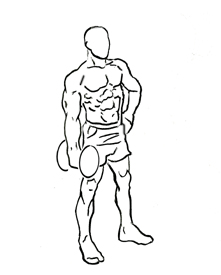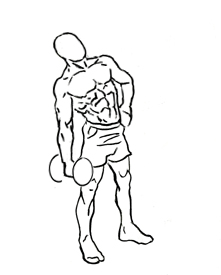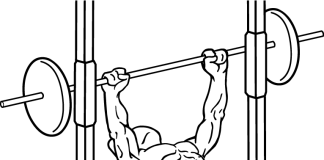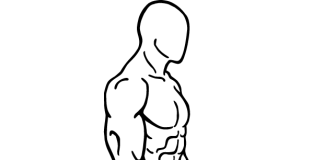Last Updated on September 30, 2022
The Side Bend with Dumbbell is a simple yet effective exercise for targeting the obliques—the muscles running along the sides of your abdomen. Strong obliques are essential for core stability, better posture, and greater overall strength. This exercise is particularly great for those looking to tone and define their waistline while improving lateral stability.
In this guide, we’ll cover everything you need to know about the Side Bend with Dumbbell: the correct technique, benefits, tips to maximize results, common mistakes, and advanced variations. Let’s dive in and learn how to get the most from this essential core-strengthening move.
1. Exercise Overview: What is the Side Bend with Dumbbell?
The Side Bend with Dumbbell is a core exercise focusing on the obliques. This movement involves holding a dumbbell in one hand and bending at the waist to one side, then returning to an upright position. This lateral movement isolates the oblique muscles, helping to build strength, stability, and definition.
Aside from its direct impact on the obliques, the Side Bend also engages the lower back and hips to a lesser degree, helping build a well-rounded core that supports functional movements and improves overall stability.
2. Step-by-Step Guide to Performing the Side Bend with Dumbbell
Step 1: Starting Position
- Stand upright with your feet shoulder-width apart. Keep your knees slightly bent to maintain stability and reduce strain on your lower back.
- Engage your core by drawing your belly button towards your spine. This helps you maintain a stable, braced position and protects your lower back.
Step 2: Grasping the Dumbbell
- Hold a dumbbell in one hand, letting it hang naturally at your side. Keep the other arm extended by your side or place it on your hip for added balance.
- Choose a manageable weight. Starting with a lighter weight will allow you to master the movement before progressing to heavier dumbbells.
Step 3: The Side Bend Motion
- Begin bending at the waist, lowering the dumbbell toward the floor as far as you comfortably can. Move slowly and deliberately to keep tension on the obliques.
- Be mindful to bend only at the waist and avoid using your hips or knees. The aim is to isolate the oblique muscles on the side of the body opposite the dumbbell.
Step 4: Returning to Starting Position
- Slowly return to an upright position, using your obliques to lift yourself back up. Control the movement, avoiding any jerking or sudden shifts.
- Exhale as you return to the top position, squeezing your obliques at the end of the movement for maximum engagement.
Step 5: Switch Sides and Repeat
- After completing the desired number of reps on one side, switch the dumbbell to your other hand and repeat the exercise. Ensure both sides receive equal focus to maintain balance.
3. Benefits of the Side Bend with Dumbbell
The Side Bend with Dumbbell offers several unique benefits that make it an excellent addition to any workout routine:
- Strengthens and Defines the Obliques: This exercise is one of the best for isolating the obliques, helping you build strength and develop the “V-shape” definition many people aim for in their waistlines.
- Improves Core Stability: Strengthening the obliques contributes to overall core stability, which supports movements like squats, deadlifts, and overhead lifts. A strong core also helps prevent lower back injuries.
- Enhances Functional Strength: The Side Bend mimics the bending and twisting motions used in daily activities, such as reaching for objects or lifting and carrying items. By strengthening the obliques, this exercise prepares your body for these movements, reducing the risk of strain or injury.
- Promotes Better Posture: Weak obliques can contribute to poor posture, especially in the lower back. Strengthening these muscles can improve alignment, helping you stand taller and reduce strain on your spine.
4. Common Mistakes to Avoid
To ensure you get the most out of the Side Bend with Dumbbell, avoid these common mistakes:
- Using Momentum: Some people tend to “swing” or use momentum to return to the upright position, which can reduce the tension on the obliques and compromise results. Focus on controlled, slow movements to maximize engagement.
- Bending at the Hips or Knees: Allowing your hips or knees to bend can shift focus away from the obliques and onto other muscles. Keep your hips stable and knees slightly bent, but not actively involved in the movement.
- Arching the Lower Back: If you’re not engaging your core properly, your lower back may arch, leading to potential strain. Always draw in your abs to protect your spine and keep your posture stable.
- Using Too Much Weight: Starting with a heavy dumbbell can lead to form breakdown. Begin with a lighter weight until you’re comfortable with the technique, then gradually increase as your strength improves.
5. Tips to Maximize Results
Here are some expert tips to help you get the most from the Side Bend with Dumbbell:
- Focus on Core Engagement: Remember to brace your core and keep your abs tight throughout the movement. This not only ensures maximum engagement of the obliques but also stabilizes your spine.
- Start with Light Weights: Begin with a manageable weight, especially if you’re new to the exercise. This helps you master the form without risking injury. Once you’re comfortable, you can increase the weight to challenge the muscles further.
- Controlled Breathing: Inhale as you lower the dumbbell, and exhale as you lift it back to the starting position. This breathing rhythm helps you control the movement and prevent unnecessary strain on the neck or lower back.
- Practice Balance: Ensure that you perform the same number of reps on each side to avoid muscle imbalances. This not only looks better but also supports even core strength, which helps with posture and performance in other exercises.
6. Variations and Modifications
To keep your routine engaging or adapt the Side Bend with Dumbbell to different fitness levels, try these variations:
- Single-Arm Overhead Dumbbell Side Bend: Instead of holding the dumbbell by your side, hold it overhead. This variation engages the shoulders and increases the challenge for the core by requiring greater stability.
- Seated Dumbbell Side Bend: If you’re concerned about using momentum, try this exercise seated. Sitting down helps eliminate body movement and ensures that your obliques are doing all the work.
- Cable Side Bend: Use a cable machine with a handle attachment instead of a dumbbell. The cable provides constant resistance throughout the movement, helping to intensify the exercise.
- Side Bend with Resistance Band: For a lighter resistance option, perform the side bend with a resistance band anchored under one foot. This is ideal for beginners or those looking for a gentle way to warm up the obliques.
- Side Bend with Plate: Hold a weight plate close to your chest or at your side instead of a dumbbell. This allows for more control, especially with heavier weights, and offers a slight change in grip that can feel more comfortable.
7. Integrating the Side Bend with Dumbbell into Your Workout Routine
Including the Side Bend with Dumbbell in your workout routine can bring significant benefits to your core training. Here’s how to make the most of it:
- Reps and Sets Recommendations: For core strength, aim for 2-3 sets of 12-15 reps on each side. If your goal is muscle endurance, increase the reps to 15-20 with a lighter weight.
- Best Pairings: Pair the Side Bend with other core exercises like Russian twists, planks, and bicycle crunches for a well-rounded oblique workout. It’s also an excellent addition to upper body workouts where you’re working the shoulders and back.
- Rest Intervals: Allow 30-45 seconds of rest between sets. This gives your muscles enough time to recover while keeping the workout intensity high.
8. How to Track Progress
To ensure consistent improvement, track your progress with the Side Bend with Dumbbell over time:
- Log Your Weight and Reps: Keep a record of the weight used and the number of reps you complete. Increase the weight in small increments every few weeks for progressive overload.
- Assess Form and Range of Motion: Periodically record yourself performing the exercise or have a trainer check your form. This helps ensure you’re bending correctly at the waist without using the hips or knees.
- Check for Balanced Strength: Monitor your performance on each side. If one side feels stronger, add a few extra reps to the weaker side until you feel an even engagement in both obliques.
9. Frequently Asked Questions
Q: Can I do Side Bends every day? A: While it’s safe to do side bends regularly, it’s best to give your muscles time to rest between sessions. Aim to incorporate this exercise into your routine 2-3 times per week for best results.
Q: How heavy should the dumbbell be for Side Bends? A: Start with a weight you can control comfortably. For beginners, a 5-10 lb dumbbell is a good starting point. As you gain strength, increase the weight gradually to continue challenging your obliques.
Q: Should I perform this exercise fast or slow? A: Always perform side bends slowly and with control. Faster movements can cause momentum to take over, reducing the effectiveness of the exercise and increasing the risk of strain.
Conclusion
The Side Bend with Dumbbell is an essential exercise for anyone looking to build stronger obliques, improve core stability, and develop a more defined waistline. This movement isolates the oblique muscles effectively, helping to enhance both functional and aesthetic aspects of core strength.
Remember, technique is key to reaping the full benefits of the Side Bend with Dumbbell. By following the proper form, avoiding common mistakes, and incorporating the suggested tips and variations, you’ll be able to take your core training to the next level.
So, add the Side Bend with Dumbbell to your workout, keep your movements controlled, and watch your core strength and definition improve over time!








